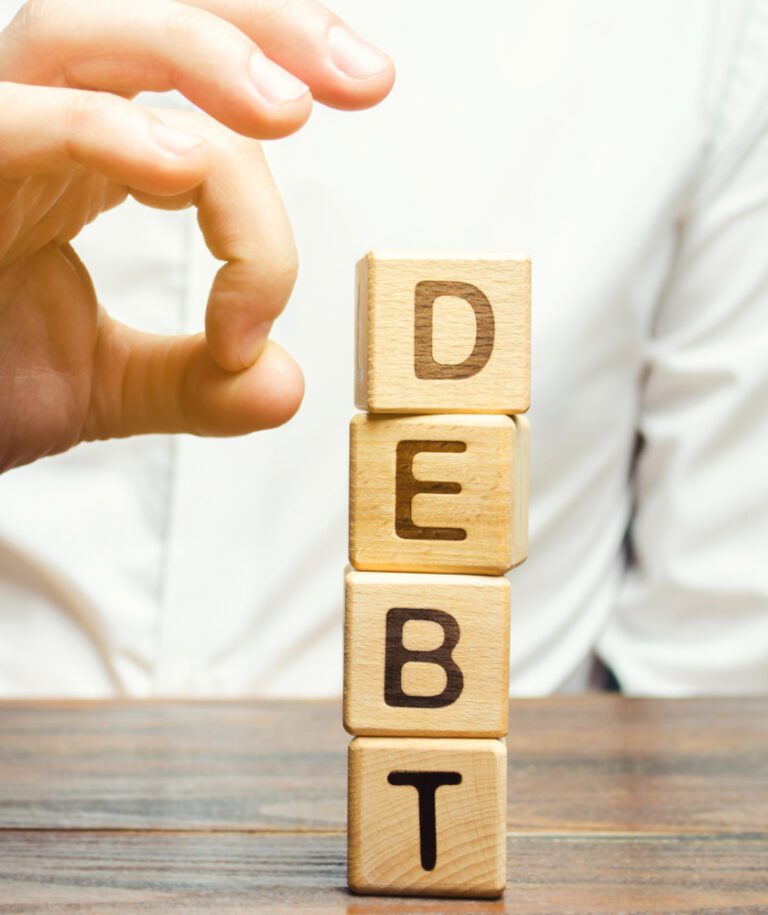
Debt Solutions
Struggling with debt? There are options available to help with debt problems. The UK has both formal and informal debt solutions, and each works differently to suit different financial difficulties.
At NDH Financial, we specialise in IVAs. If you'd like to discuss whether an IVA could work for you, speak to one of our insolvency practitioners.
An IVA may not be suitable in all circumstances.
Fees apply. Your credit rating may be affected.
Individual Voluntary Arrangement
What is an IVA?
An individual voluntary arrangement (or IVA) is a legally binding agreement between you and your creditors to repay what you can afford over five to six years. Available to residents of England, Wales and Northern Ireland, it requires 75% of creditors (by debt value) to approve the proposal.
Once approved, interest and charges are frozen, giving you temporary protection from your creditors. Any remaining debt is written off at the end**, helping you get out of debt - provided you've kept to the agreement. A licensed insolvency practitioner handles your case and distributes your affordable monthly debt payments to creditors after deducting their fees.
What debts can be included in an IVA?
An IVA can include most types of unsecured debts, including:
- Credit cards debt
- Personal loans
- Overdrafts
- Store cards
- Payday loans
- Catalogue debts
- Buy now, pay later schemes
- Money owed to friends or family
However, certain debts cannot be included in an IVA, such as:
- Student loans
- Court fines and magistrates' fines
- Child support and maintenance payments
- TV licence arrears
- Social fund loans
- Debts arising from fraud
Who can get an IVA?
You could qualify for an IVA if you:
- Have unsecured debts of around £7,000 or more
- Receive a steady income from work (including self-employment) or a pension
- Can manage a regular payment each month
- Owe money to more than one creditor
- Want a legally protected way to deal with your debts and work towards financial freedom*
We may be able to help pay off your debts
IVAs are our area of expertise at NDH Financial. Our insolvency practitioner brings over 15 years of experience in personal insolvency, helping people across England, Wales and Northern Ireland get help when debt feels unmanageable.

Debt Management Plan
What is a Debt Management Plan?
A Debt Management Plan (DMP) is an informal arrangement with your creditors to pay your debts at a rate you can afford. Unlike an IVA, it's not legally binding, so creditors aren't obligated to accept it and can still add interest or take action. You make one monthly payment to a provider who distributes it to creditors.
What debts are included in a DMP?
A Debt Management Plan typically covers unsecured, non-priority debts such as:
- Credit card debts
- Personal loans
- Store cards
- Overdrafts
- Payday loans
A DMP generally won't cover priority debts like:
- Mortgage or rent arrears
- Council tax arrears
- Court fines
- Child maintenance
- Gas and electricity bills
Who can get a DMP?
A Debt Management Plan might be suitable for you if you:
- Have unsecured debts you're struggling to repay at the current rate
- Can afford to make a monthly payment towards your debts
- Want a simpler way to manage multiple creditor payments
- Don't meet the criteria for a formal insolvency solution like an IVA
- Are willing to work with your creditors informally
Because a DMP is not legally binding, creditors can still add interest and charges to your debts, and they may refuse to cooperate or take legal action. The duration of a DMP depends on how much you owe and how much you can afford to pay each month. When choosing a DMP provider, check they're authorised and regulated by the Financial Conduct Authority (FCA).
Debt Relief Order
What is a Debt Relief Order?
A Debt Management Plan (DMP) is an informal arrangement with your creditors to pay your debts at a rate you can afford. Unlike an IVA, it's not legally binding, so creditors aren't obligated to accept it and can still add interest or take action. You make one monthly payment to a provider who distributes it to creditors.
You'll need an approved debt advisor to help with the application and provide debt advice.
What debts can be included in a Debt Relief Order?
Debts that can be included:
- Credit card debts
- Overdrafts
- Benefit overpayments
- Buy now, pay later schemes
- Personal loans
- Money owed to friends and family
Debts that cannot be included:
- Magistrates' court fines
- Child support and maintenance payments
- Student loans
- Debts incurred through fraud
- Social fund loans
Who can get a Debt Relief Order?
A Debt Relief Order may be suitable if you:
- Have total debts of less than £50,000
- Have less than £75 left each month after paying essential household expenses
- Do not own your own property
- Have assets worth less than £4,000 (with certain exemptions, such as a vehicle worth up to £2,000 if you need it for work or mobility)
- Have not had a DRO in the last six years
- Are not currently in an IVA or bankruptcy
- Have lived or worked in England, Wales or Northern Ireland for at least three years
If your circumstances change during the 12-month DRO period, like receiving an inheritance or a pay rise, you may need to inform the Official Receiver, and the DRO could be revoked.
Bankruptcy
What is Bankruptcy?
Bankruptcy is a legal process that writes off unsecured debts you can't afford to repay. When a bankruptcy order is made, control of your assets passes to the Official Receiver or a trustee, who can sell them (including your home if, although certain assets are exempt such as household items of reasonable domestic need, tools of trade and cars less than £3,000. Bankruptcy usually lasts 12 months, after which you're discharged, and the remaining qualifying debts are written off. Restrictions apply during bankruptcy, including limitations on credit and certain professions.
What debts can be included in Bankruptcy?
Debts that can be included:
- Credit card debts
- Personal loans
- Overdrafts
- Benefit overpayments
- Buy now, pay later schemes
- Money owed to friends and family
Debts that cannot be included:
- Magistrates' court fines
- TV licence arrears
- Student loans
- Debts arising from fraud
- Social fund loans
- Child maintenance and CSA arrears
Who can file for Bankruptcy?
Bankruptcy may be appropriate for you if you:
- Have unsecured debts you cannot afford to repay
- Do not own significant assets (or are prepared to lose them)
- Have no realistic prospect of your financial situation improving
- Are unable to maintain payments under an IVA or DMP
- Are based in England, Wales or Northern Ireland
It's important to carefully consider bankruptcy, especially if you own assets or work in a profession where bankruptcy could affect your employment. The fees charged by the Official Receiver and any appointed trustee can be substantial, particularly if you own a property or other significant assets.

Can NDH help?
While we can’t help you file for bankruptcy directly at NDH Financial, we're happy to review your circumstances and discuss whether an Individual Voluntary Arrangement may be an appropriate situation.
Debt Consolidation Loans
What is a Debt Consolidation Loan?
A debt consolidation loan involves taking out a new loan to pay off multiple existing debts, resulting in a single monthly payment. Secured loans use an asset (like your home) as security - they may offer lower rates, but the lender can repossess the asset if you don't pay. Unsecured loans aren't tied to any asset but typically have higher interest rates, especially with poor credit.
What debts can be included in a Debt Consolidation Loan?
You can typically use a debt consolidation loan to repay:
- Credit card debts
- Personal loans
- Overdrafts
- Store cards
- Payday loans
Who can get a Debt Consolidation Loan?
A debt consolidation loan may be suitable if you:
- Have multiple debts with different creditors
- Can afford the monthly repayments on a consolidation loan
- Have a reasonable credit score (for unsecured loans)
- Want to simplify your finances with one monthly payment
Before taking out a consolidation loan, it's crucial to check whether you'll actually save money. In some cases, the total amount you repay could be higher than if you'd kept your existing debts, especially if the loan term is extended or the interest rate is high. If considering a secured loan, remember that your home is at risk if you cannot keep up with repayments.
Equity Release
What is Equity Release?
Equity release allows homeowners aged 55+ to access money tied up in their property without having to sell it. The amount depends on your age, home value, and remaining mortgage balance.
Main types: Lifetime mortgage (borrow against your home, interest rolls up, repaid when property is sold), Interest-only lifetime mortgage (make monthly interest payments), Home reversion plan (sell all/part of your home for a lump sum while living there rent-free), and Retirement mortgage (secured against property, repaid when sold). Money can be received as a lump sum or smaller amounts over time.
What debts can Equity Release help with?
Equity release can be used to repay various types of debts, including:
- Credit card debts
- Personal loans
- Outstanding mortgage balances
- Other unsecured debts
Who can get Equity Release?
Equity release may be suitable if you:
- Are aged 55 or over
- Own your own home (or have significant equity in it)
- Want to access money tied up in your property
- Need funds to repay debts or supplement your income
- Plan to remain in your home for the foreseeable future
Equity release reduces the value of your estate and may affect your entitlement to means-tested benefits. You should seek independent financial advice before proceeding with any equity release plan.
Remortgage
What is a Remortgage?
Remortgaging means switching your mortgage to a new deal. It can help manage debts by releasing equity (borrowing more than your current balance to pay off other debts) or reducing monthly payments (switching to a lower rate or extending the term, freeing up money for other debts).
What debts can a Remortgage help with?
Remortgaging can help you repay:
- Credit card debts
- Personal loans
- Overdrafts
- Car finance
- Other unsecured debts
Who can get a Remortgage?
A remortgage might be suitable if you:
- Own your home and have built up some equity
- Are looking for a better mortgage deal
- Can afford the new monthly payments
- Want to consolidate debts into your mortgage
Keep in mind that remortgaging to consolidate debts means you're converting unsecured debts into a secured debt. If you fail to keep up with your mortgage payments, your home could be repossessed. You should also consider whether extending your mortgage term will result in paying more interest overall.
Secured Loans
What is a Secured Loan?
A secured loan is backed by an asset (usually your home or car). Because the lender has security, they can offer larger amounts and may accept applications with poor credit. The risk: if you can't keep up repayments, the lender can repossess the asset. The main types are homeowner loans (secured against property), vehicle loans (secured against a car), and secured credit cards (which require a cash deposit as collateral).
What debts can a Secured Loan help with?
Secured loans can be used to consolidate:
- Credit card debts
- Personal loans
- Overdrafts
- Payday loans
- Other unsecured debts
Who can get a Secured Loan?
A secured loan may be an option if you:
- Own an asset (like a home or car) that can be used as security
- Need to borrow a larger amount of money
- Have a poor credit history and struggle to get unsecured credit
- Can afford the monthly repayments
Before taking out a secured loan, you must check that you can afford the repayments. Defaulting on a secured loan can result in the repossession of your home or vehicle, so it's essential to consider the risks carefully.
Protected Trust Deed
What is a Protected Trust Deed?
A Protected Trust Deed (PTD) is a formal debt solution for Scottish residents, similar to an IVA. You make affordable monthly payments for three to four years, then the remaining qualifying debt is written off. A licensed insolvency practitioner (trustee) administers the PTD and negotiates with creditors on behalf of the debtor.
When you enter a PTD, you transfer asset ownership to the trustee, who may sell them to repay debts. For a trust deed to become "protected", a majority of creditors (by value) must agree. Once protected, creditors can't take further legal action.
What debts can be included in a Protected Trust Deed?
A Protected Trust Deed can include most unsecured debts, such as:
- Credit cards
- Personal loans
- Overdrafts
- Store cards
- Payday loans
However, it cannot include:
- Secured debts (like mortgages)
- Court fines
- Child support
- Student loans
Who can get a Protected Trust Deed?
A Protected Trust Deed may be suitable if you:
- Live in Scotland
- Have unsecured debts of at least £5,000
- Have a regular income and can afford monthly payments
- Owe money to multiple creditors
- Want a formal, legally protected debt solution
Debt Arrangement Scheme
What is a Debt Arrangement Scheme?
A Debt Arrangement Scheme (DAS) is a formal debt management programme overseen by the Scottish Government. You make one affordable monthly payment (based on disposable income) that's distributed among creditors. While you keep up payments, creditors can't take enforcement action and interest/charges are frozen. Unlike an IVA or PTD, you must repay debts in full within a reasonable timeframe - remaining debts aren't written off.
What debts can be included in a Debt Arrangement Scheme?
A DAS can include most types of unsecured debts, such as:
- Credit card debts
- Personal loans
- Overdrafts
- Catalogues and store cards
Who can get a Debt Arrangement Scheme?
A DAS may be suitable if you:
- Live in Scotland
- Owe money to more than one creditor
- Have some disposable income after paying essential bills
- Are able to repay your debts in full over time
- Want protection from creditor action while you repay your debts
If you cannot repay your debts in full within a reasonable period, a DAS is unlikely to be the right solution for you.
Sequestration
What is Sequestration?
Sequestration is Scottish bankruptcy. To apply, you usually need a certificate for sequestration from an authorised money advisor, or you can apply without one if you're "apparently insolvent" (e.g. received a statutory demand and can't pay within 21 days).
Once sequestrated, your assets may be sold to repay creditors. Sequestration typically lasts 12 months, after which you're discharged, and the remaining debts are written off. The application fee is £150 (which may be reduced/waived if you receive certain benefits).
What debts can be included in Sequestration?
Sequestration covers most unsecured debts, including:
- Credit card debts
- Personal loans
- Overdrafts
- Buy now, pay later schemes
However, it does not include:
- Court fines
- Student loans
- Child support payments
Who can get Sequestration?
You may be able to apply for sequestration if you:
- Live in Scotland or have lived there for at least one year
- Have debts of at least £3,000
- Have not been made bankrupt in the last five years
- Cannot afford to repay your debts
Start Your Debt Solution Journey Today
Choosing the right debt solution depends on your individual circumstances, including the amount you owe, your income, your assets, and where you live. There's no one-size-fits-all answer, which is why it's important to seek advice to find the best solution before making any decisions.
At NDH Financial, we specialise in Individual Voluntary Arrangements and have helped thousands of people find a way out of debt. Our specialist insolvency experts can assess your situation during a no-obligation consultation and help you understand which debt solution is right for you.
If you're struggling with mounting debts, dealing with creditor pressure, or simply looking for a clearer path to becoming debt-free, we're here to help you take the first step towards financial freedom*.

